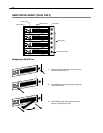
29
Looping Output Termination
When terminating the outputs becomes necessary, the recorder has built in termination that allows you to select individual outputs to terminate
individually. It is not always necessary to terminate the output when using it. It is dependent on the device with which you are connecting it to.
As a rule, if the image appears distorted or virtually unviewable, it most likely needs to be terminated.
Always leave the dipswitch set to the ON position when the Looping Outputs are not used.
Connecting a PTZ Camera
Setting up a PTZ Camera is simple. The recorder comes preassembled with an internal PTZ adapter. The cabling may be run up to 4,000 ft
using 22 Gauge Twisted Pair.
It is important to understand how the PTZ connects to the recorder. The recorder outputs an RS-232 signal and converts in to an RS-485 signal
which is then sent to the PTZ camera.
Attaching the 4-Pin Adapter
1. Locate the PTZ adapter cable
2. Connect the wires of the PTZ adapter to the PTZ camera. The yellow wire should
connect to the RX+ on the camera and the orange wire should connect to the RX-.
3. Connect the other end of the adapter to the XVR unit as shown.
4. Assign the PTZ camera an ID number in PTZ Setup that coincides with the number
assigned to the camera. This is normally done utilizing a dip-switch configuration
method on the addressable dome.
Example: If the camera is plugged into input number 5, set the PTZ unit to ID number
5.
ON Not connected to a monitor (Normal)
OFF Connected to a monitor (Looped)
RS-422
Signal Line (+)
Signal Line (-)


















